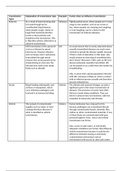Transmission Explanation of transmission type Example Factors that can influence transmission
types
Airborne As a result of bacteria being able Influenza Tightly packed areas, where people are in close
to travel through air for range to one another, such as on a train or
considerably long distances, bus, where people are sneezing and coughing
when people cough, sneeze or or even laughing, can be a factor to the
laugh their bacterial infection transmission of airborne diseases.
travel on dust particles and
droplets to the next person. This
is therefore what is referred to as
airborne transmission.
STD STD transmission is the spread of HIV An environment that is merely educated about
a virus or disease by sexual sexually transmitted diseases are much more
intercourse. However diseases inclined to spread the disease rapidly, because
such as herpes aren’t exclusively if there a lack of education on this topic, why
transmitted through sexual would anyone be worrying of something they
contact, but can be passed on by don’t know? Moreover, STD’s such as HIV isn’t
simply kissing an area near the always exclusively sexually transmitted. HIV
infected area (with sores (body can be passed on to a child from the mother by
fluids such as blood)). breastfeeding.
Also, in areas with a great population infected
with HIV, someone is likely to come in contact
with an infected person sexually and therefore
become infected too.
Vector Blood feeding anthropoids such Malaria The climate and seasonal changes can play a
as fleas or mosquitoes, which significant part in the vector transmission of
carry infectious pathogens and diseases. The presence of vector host often
transmit it to humans by biting thrives in moist damp conditions. They can
thrive in almost every environment, with the
exception of extremely cold climates.
Vehicle The spread of contaminated Cholera Human behaviour has a big part to this
supplies such as water or food because pathogens are transmitted directly
causing infectious diseases is through contaminated hands, domestic flies,
what is classified as vehicle clothes or other contaminated materials. If any
transmission. of these items are contaminated with poor
personal hygiene, fever, vector and vehicle
transmission can thrive.
Also, access to safe water, or technically
adequate sanitations are factors that influence
vehicle transmission because it could be the
difference between having an extremely
contaminated environment and an
environment with access to clean safe water.





